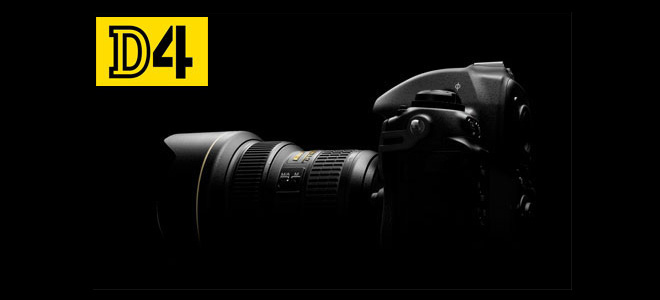
The Nikon D4 will soon be unveiled and will jump the availability of the Canon 1DX by going on sale in February.
The camera has a 16MP full frame sensor and completely revamped video mode with some new features not seen before on a Nikon.
The camera appeared online briefly today before being taken down, according to Nikon Rumors. Nethertheless NR were able to gather some interesting specs.
The Nikon D4 is a $6000 full frame DSLR aimed at pros.
- 16MP full frame sensor (this is going to be killer for low light. I am so glad they did not put a Sony 36MP CMOS in this camera)
- Maximum ISO of 204,800
- Video at 1080/30/24p and 720/60p
- Support for XQD Compact Flash cards
Nikon have so far lagged seriously behind with DSLR video but the situation improved with the advent of Expeed 3 in the Nikon J1 mirrorless camera. This has decent resolution but it is not entirely free of moire / aliasing, and the sensor is tiny.
What is new on the video side?
H.264 with b-frame encoding
The Nikon D4 has a new encoder with support for b-frames. A long GOP codec is not quite as good image quality wise as an I-frame codec like AVC Intra on the hacked GH2 or the All-I mode on the Canon 1DX but it is far more efficient to encode this way, it saves a lot of space. B-frames help the image quality of H.264 based video streams by more accurately reconstructing image data in between actual (real) I-frames. The GH2 currently has the best encoder and it features b-frames in AVCHD mode. They prevent the break up of the image under stress like we saw on the original GH1.
No mention of bitrates yet – the official announcement on Friday should cast light on that.
Low pass filter for video
In video, a low pass filter is just another name for an anti-aliasing filter. This will help prevent moire and aliasing like the Mosaic Engineering VAF-5D2 for the 5D Mark II. Since aliasing and moire from a down-sampled high megapixel sensor causes a lot of false detail, encoding benefits from an anti-aliasing filter since more of the available bitrate can be allocated to real detail. It is unclear how Nikon have achieved this without impacting the sharpness of stills when viewed at 1:1 (say in a pixel peeping review). If it is an optical low pass filter it must drop in front of the sensor during video recording and move out of the way for stills. It could (more likely) be electronic.
Contrast detect AF and smooth aperture for video recording
Decent contrast detect AF and aperture control in video mode require support on the lens side to really work. The AF motors and iris of Nikon lenses are not silent. The inclusion of these features may hint at video optimised lenses coming from Nikon in 2012, but more likely they are in there on a ‘because we could’ basis. ‘Smooth aperture’ will probably work by controlling the aperture of the lens is a continuously variable mode, if such a thing is possible with existing Nikon glass.
Dedicated video button next to shutter button (and illuminated)
A statement of intent.


